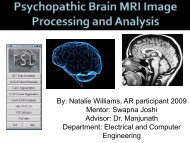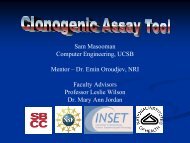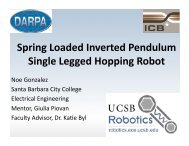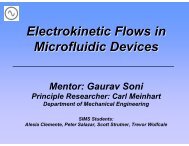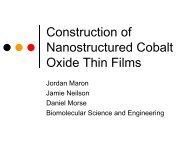Gas Chromatography Isotope Ratio Mass Spectrometer (GC IRMS)
Gas Chromatography Isotope Ratio Mass Spectrometer (GC IRMS)
Gas Chromatography Isotope Ratio Mass Spectrometer (GC IRMS)
You also want an ePaper? Increase the reach of your titles
YUMPU automatically turns print PDFs into web optimized ePapers that Google loves.
Microbes in Petroleum Oil andNatural <strong>Gas</strong> Seepage Areas• By Tulsi Patel• Mentor: Haibing Ding• Advisor: David Valentine
Why Look at Methane and Methanotrophs?•Contributes greatly to the greenhouse effect•3 rd most abundant greenhouse gas inatmosphere•While methane is less abundant in the atmosphere, it is 20times more effective than CO 2 at the molecular level interms of greenhouse gases•Most methane is consumed by methanotrophs and is notreleased into the atmosphere
Location of Seepage Into SedimentShane seepBrian seepSea waterOxic sediment layerAnoxic sediment layermethane
Objectives:•Test if benzoate is an intermediary in the process ofmicrobes converting methane to carbon dioxide•Determine what types of bacteria are growing in the seawater layerSea waterOxic sediment layerAnoxic sediment layer
Benzoate•When benzoic acid is stripped of a hydrogen atom,it becomes benzoateCOOHCOOHHCCCCCCHHH + =HHCCCCCCHHHHBenzoic acidBenzoate
Why Benzoate?•Many other organisms and microbes can makebenzoate for use as an intermediary for theirrespiration processG. MetallireducensBacillus stearothermophilushttp://biyolojiegitim.yyu.edu.tr/k/Bacilu/images/Bacillus%20stearothermophilus_jpg.jpghttp://www.geobacter.org/images/Geobacter-Fe(III)-sm.jpghttp://microbewiki.kenyon.edu/images/9/9a/G.metallidreducens.jpghttp://commtechlab.msu.edu/SITES/dlc-me/zoo/zdc0310.jpg
…And How Does This Work?• 12 C is the most abundant form of carbon on theplanet• 98.89% of the Earth’s carbon is 12 C• The remaining 1.11% is 13 C and 14 C• We used methane with 13 C carbon so that it wouldbe easier to track13CH 413CH 413CH 4Liquid from sediment13CH 413CH 4Anoxic sediment layer
<strong>Gas</strong> <strong>Chromatography</strong> <strong>Isotope</strong> <strong>Ratio</strong><strong>Mass</strong> <strong>Spectrometer</strong>(<strong>GC</strong> <strong>IRMS</strong>)Mixture inserted here (250 °C)Combustion ofgasesproduces CO 2Separates incolumn
<strong>Gas</strong> <strong>Chromatography</strong> <strong>Isotope</strong> <strong>Ratio</strong><strong>Mass</strong> <strong>Spectrometer</strong>(<strong>GC</strong> <strong>IRMS</strong>)•<strong>Mass</strong> filter determinesisotope•Molecules directedtowards detector•44 = 2 16 O + 12 C•45 = 2 16 O + 13 C•46 = 16 O + 18 O + 12 C
Enrichment in Sampleabundance13CO 244454613CH 4time•Methane is solely 13 C•CO 2 is highly enriched with 13 C
Difference of <strong>Isotope</strong> <strong>Ratio</strong>sδ 13 C < 0abundanceMethylbenzoate ester(Peak 5)gtimePeak Nr.δ 13 C5 -27.184•there is less 13 C in thesample than in thestandard compoundδ 13 C = 0• both amounts of 13 C areequalδ 13 C > 0• there is more 13 C in thesample than in thestandard compound
Results of <strong>GC</strong>-<strong>IRMS</strong>CompoundMethaneδ 13 C∞CH 4CarbonDioxide9399.8CO 2Benzoate-27.2
Microbial Mats Through MicroscopesThe methanotrophs that we arelooking for cannot be identified fromthe microscopesBacteria through the electronmicroscopeBacteria through compoundmicroscope
Filament of BacteriaGranules(typical characteristicof sulfur oxidizer)
Elemental AnalyzerSignal intensitySulfur•Sulfur oxidizer is the onlyproducer of elementalsulfur in the seep area•It converts hydrogensulfide into sulfur andlater sulfateelements
<strong>GC</strong>MS Data<strong>Gas</strong> <strong>Chromatography</strong> <strong>Mass</strong> SpectrometryAbundanceAbundance500004500040000350003000025000200005581159Scan 2843 (31.264 min): DHB0709.D157203123362Molecular weight of Cis-8-hexadecenoic150001000050000m/z-->235267179 297331395421447491 52754850 100 150 200 250 300 350 400 450 500 550Molecular weight•Location determines structure which determines type of bacteria•We found Cis-8-hexadecenoic which is only created by methanotrophs•Therefore, methanotrophs are present in the sea water
Conclusion• Benzoate is not an intermediary in the microbes’conversion of methane to carbon dioxide• Sulfur oxiders are present on the microbial mats• The presence of Cis-8 proved that methanotrophsare also present on the mats• Further research can help us determine whatexactly the intermediary is and• We can discover the relationship betweenmethanotrophs and sulfur oxidizers
AcknowledgementsTHANKS TO…Haibing DingThe Valentine LabThe Analytical Lab of Earth ScienceJensMikeMy fellow CNSI ResearchesAnd Mom and Dad for driving me everyday ☺



